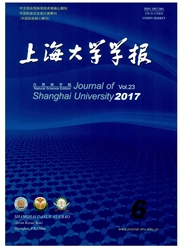

 中文摘要:
中文摘要:
将乙酰丙酮锌和乙酰丙酮铁分别作为有机锌源和有机铁源,采用溶胶凝胶法成功合成出一种新型有机体基锌铁双金属材料,该材料对水体有机污染物具有良好的光催化降解作用.分别利用X射线衍射(X-ray diffraction,XRD)、元素分析(elemental analysis,EA)、紫外-可见吸收光谱(UV-Vis diffuse reflection spectrum,UVPC)、电感耦合等离子体发射光谱(inductively coupled plasma emission spectrometry,ICP-AES)、傅里叶变换红外光谱(Fourier transform infrared spectroscopy,FT-IR)等仪器分析的方法对此材料结构和组成成分进行了分析,结果表明:该材料具有层状结构,层间距约为8.74 nm;材料中元素铁、锌和碳的质量分数分别为8.39%、25.73%和39.64%;材料中发现了乙酰丙酮和金属氧键的存在.以刚果红、罗丹明B以及苯胺分别作为阴离子、阳离子和非离子有机污染物的代表,考察了该材料的可见光的光催化活性及选择性.结果表明:在光照条件下,催化剂对阴离子染料刚果红光催化3 h后的单位去除量为99 mg/g,对阳离子染料罗丹明B的单位去除量为36 mg/g,而对非离子有机污染物苯胺的单位去除量只有32 mg/g,因此该材料对阴离子染料有良好的选择性光催化性能.
 英文摘要:
英文摘要:
Zinc acetylacetonate and iron acetylacetonate are used as sources of organic zinc and organic iron to successfully synthesize a new type of organism-based zinc-iron bimetallic material using the sol-gel method. This organic material has wonderful photocatalytic performance for degrading organic contaminants in water. Several techniques including X-ray diffraction (XRD), elemental analysis (EA), UV-Vis diffuse reflection spectrum (UVPC), inductively coupled plasma emission spectrometry (ICP-AES) and Fourier transform infrared spectroscopy (FT-IR) are used to analyze its structure and composition.It is found that this organism-based zinc-iron bimetallic material has a layered structure with a layer distance of about 8.74 nm. Contents of iron, zinc and carbon of the material are 8.39%, 25.73% and 39.64%, respectively. The material contains metal-oxygen bond and acetylacetone. Photo-catalytic activity and selectivity of the photocatalysts are evaluated by visible photo-catalytic degradation of Congo Red, Rhodamine B and aniline, respectively standing for anion organic, cationic organic and non-ionic organic. The pho- tocatalytic degradation rate of anion organic Congo Red reaches 99 mg/g by the catalyst under sunshine, the cationic organic Rhodamine B reaches 36 mg/g, and the non-ionic organic aniline is only 32 mg/g. Therefore, its selective photoeatalysis performance of anionic dyes is the best.
 同期刊论文项目
同期刊论文项目
 同项目期刊论文
同项目期刊论文
 Effective adsorption of sodium dodecylsulfate (SDS) by hydrocalumite (CaAl-LDH-Cl) induced by self-d
Effective adsorption of sodium dodecylsulfate (SDS) by hydrocalumite (CaAl-LDH-Cl) induced by self-d Sorption of Aqueous Organic Contaminants onto Dodecyl Sulfate Intercalated Magnesium Iron Layered Do
Sorption of Aqueous Organic Contaminants onto Dodecyl Sulfate Intercalated Magnesium Iron Layered Do 期刊信息
期刊信息
